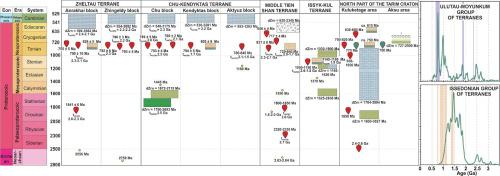Gondwana Research ( IF 7.2 ) Pub Date : 2021-09-08 , DOI: 10.1016/j.gr.2021.09.003 Anfisa V. Skoblenko , Kirill E. Degtyarev , Nadezhda A. Kanygina , Andrey A. Tretyakov , Sergey Yu. Skuzovatov , Kwan-Nang Pang , Hao-Yang Lee

|
Precambrian metamagmatic complexes of the Zhingeldy and Kendyktas blocks of the Zheltau and Chu-Kendyktas terranes of the SW part of the Central Asian Orogenic Belt (CAOB) consist of predominant Neoproterozoic orthogneisses with the estimated protolith ages of ca. 790–800 Ma, and subordinate epidote and garnet amphibolites, metabasalts and metadolerites of the lower metamorphic grades. The orthogneisses are characterized by negative εNd(t) values of -12 to -4 with Nd model ages of 2.3–1.7 Ga, indicating their protoliths could have formed by a reworking of the Palaeoproterozoic crustal materials. Precambrian metavolcanic rocks in the studied region are rhyolites with the estimated crystallization ages of ca. 800–830 Ma, and are associated with metabasalts. Metasedimentary complexes in the studied region consist of intensively retrogressed garnet-mica schists interlayered with marmorized limestones, metasilicic rocks, epidote and garnet amphibolites and strongly altered eclogites. The inferred protoliths of the garnet-mica schists are terrigenous rocks accumulated during the latest Ediacaran – middle Cambrian and formed from Mesoproterozoic (ca. 1.0 Ga) and to a lesser extent Palaeoproterozoic felsic source rocks (ca. 1.6–1.7 Ga and ca. 2.5 Ga). The garnet-mica schists of the Kendyktas block have negative εNd(t) of -13.4 and a model age tNd(DM) of 2.2 Ga, implying formation of their protolith from Palaeoproterozoic crustal source. The studied Zheltau and Chu-Kendyktas terranes from the SW part of the CAOB have much in common in terms of Precambrian and Early Palaeozoic evolution and chemical compositions of the key rock types. The presence of the Early Precambrian rocks (Zheltau terrane), an abundance of the Late Mesoproterozoic (1000–1100 Ma) detrital zircons in the Ediacaran-Cambrian metasedimentary complexes and a wide distribution of the Late Neoproterozoic magmatism, are distinctive features of the studied terranes. We refer such Precambrian terranes of the western CAOB to the Ulutau-Moyunkum group where tectono-magmatic evolution is consistent with that observed from the northern part of the Tarim craton. Our results also aid comprehensive correlation of metamorphic complexes of the Precambrian terranes from the SW CAOB.
中文翻译:

中亚造山带西南部分的前寒武纪和早古生代变质杂岩:年龄、成分、区域相关性和构造亲和力
中亚造山带 (CAOB) 西南部分 Zheltau 和 Chu-Kendyktas 地体的 Zingeldy 和 Kendyktas 地块的前寒武纪超岩浆杂岩由主要的新元古代正片麻岩组成,原岩年龄估计约为 790-800 Ma,以及较低变质等级的绿帘石和石榴石角闪岩、变玄武岩和变辉石。正方麻岩的特征是负 ε Nd(t)值为 -12 至 -4,Nd 模型年龄为 2.3-1.7 Ga,表明它们的原岩可能是由古元古代地壳材料的再加工形成的。研究区域的前寒武纪变质火山岩是流纹岩,估计结晶年龄约为800-830 Ma,并与变玄武岩有关。研究区域的变沉积复合体由深度退化的石榴石-云母片岩组成,中间夹杂着碲化石灰岩、变硅质岩、绿帘石和石榴石角闪岩以及强烈蚀变的榴辉岩。推测的石榴石-云母片岩原岩是埃迪卡拉纪-中寒武纪晚期堆积的陆源岩石,由中元古代(约1.0 Ga)和少量古元古代长英质烃源岩(约1.6-1.7 Ga和约2.5 Ga)形成。嘎)。Kendyktas 地块的石榴石云母片岩具有 -13.4 的负 ε Nd(t)和模型年龄 t Nd(DM)2.2 Ga,这意味着它们的原岩是由古元古代地壳源形成的。研究的中亚盆地西南部分的Zheltau和Chu-Kendyktas地体在前寒武纪和早古生代演化以及关键岩石类型的化学成分方面有很多共同之处。早前寒武纪岩石(Zheltau 地体)的存在、埃迪卡拉纪-寒武纪变沉积复合体中丰富的中元古代晚期(1000-1100 Ma)碎屑锆石以及晚新元古代岩浆作用的广泛分布是所研究地体的显着特征. 我们将 CAOB 西部的这种前寒武纪地体称为 Ulutau-Moyunkum 群,那里的构造岩浆演化与从塔里木克拉通北部观察到的演化一致。











































 京公网安备 11010802027423号
京公网安备 11010802027423号